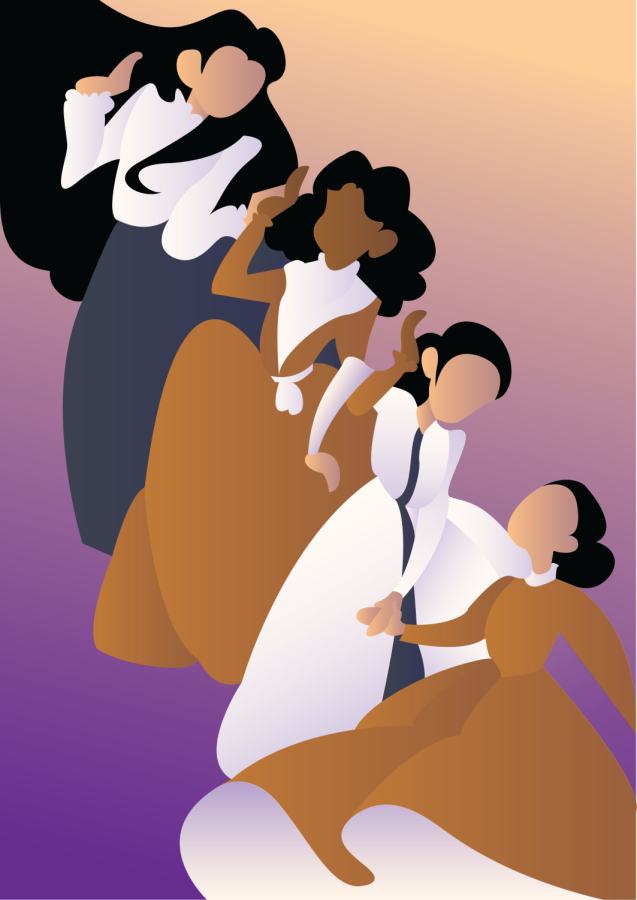“Little Women” still appeals to modern audiences
March 24, 2022
On Friday, March 18, UNA’s Cinematic Arts & Theatre Department opened up Kate Hamill’s adaptation of “Little Women” at the George S. Lindsay Theater. The show is CAT’s Spring 2022 show and features the familiar story of the March sisters with a more modern feel to it. The show came to a close on Tuesday, March 22.
“Little Women,” originally written by Louisa May Alcott, follows the four March sisters as they journey through political strife, breaking bonds, and adulthood. Jo, the headstrong second-oldest sister, is the story’s main protagonist. Most of the story is centered around her struggles with growing up and the newfound womanhood that comes with it. Stories are also told with sisters Meg, who tries to embody what society deems acceptable of a woman; Beth, who grapples with mortality and self-sacrifice; and Amy, who struggles to be seen as a woman like her sisters often are.
For third-year CAT major Hailey Drake, the work has been non-stop. Drake is the show’s Stage Manager, tasked with ensuring all goes well within every production. She managed her first show roughly two years ago and has been working as a Stage Manager since.
“Simply put, stage management is managing a production… that seems very vague for something that is one of the most important jobs in the production,” Drake said. “I have to take notes every rehearsal, I have to be at every rehearsal. Something a lot of people don’t understand about stage management is that I have to communicate with many departments.”
As for “Little Women,” Drake has enjoyed seeing the evolution of the show from blocking to dress rehearsal. She was pleasantly surprised to see every showing sell out, as everyone’s hard work will be appreciated by a full house.
“Seeing all of the actors push through and make for a really good production is my favorite part of it,” Drake said. “We spend hours on a ten-minute scene so the actors can get it in their bodies, so it can be in their bones.”
The show has also had visiting designers, who came in-person to aid in Tech Week. Throughout most of the work on the show, they have only been able to work virtually.
Drake further praised director Keelie Sheridan, who encourages actors to have organic interactions. Sheridan is a professor of CAT focusing on acting and directing, as she is a working actor and director. She recently directed her first feature film, “Planet b234,” which features her husband and stepson as the main roles.
“Directing plays is very different from directing a film,” Sheridan said. “In film, you capture the performance while shooting, and then the editing room is where you really shape the story. In theater, the editing room is the rehearsal room.”
“Little Women” is especially important to Sheridan, as it was a childhood favorite.
“I remember seeing themes of gender and equality and family roles,” Sheridan said. “It piqued my interest because the characters in the novel don’t really fit into the roles they’re supposed to. When I came across this adaptation that lifts those themes of identity to the surface, I thought it was the perfect show for right now.”
She finds the struggle of Jo’s gender identity especially fascinating. Many times in the show, Jo expresses that she does not feel like a woman. Marmee assures her that she does not have to be what society expects her to be and for her to just be herself, which feels appropriate for a modern audience.
K.P. Whisenant, who portrays the March’s maid Hannah, also sees the importance of “Little Women” to modern viewers.
“I think this [adaptation] really tackles that Jo is who she is and she’s not going to change because that’s what society says,” Whisenant said. “That is one of the reasons I really wanted to audition for this show.”
Whisenant also enjoys the connection that the actors form while in rehearsals. As the role of Hannah, Whisenant discovered that she needed to form a maternal instinct to the characters. She built off of the relationships she already had with the March actresses, and it truly shows in her performance. Acting requires collaboration, according to Whisenant. Chemistry between characters has to be built to make character relationships believable.
“I have to be believable as someone who has known [the Marches] their entire lives and has watched them grow up,” Whisenant said. “You have to think ‘here’s where we are, here’s what we do’.”
The show itself created a modern yet historical setting. All of the actors embodied their roles. Those who especially stood out were Alexandra Perez’s portrayal of Beth and Ella Neal’s Amy. Perez painted a beautiful portrait of Beth’s internal struggles. We begin to see her as her own character when she petitions Mr. Laurence to allow Laurie to join Jo’s annual Christmas show. The scene is unexpectedly heartbreaking, especially when Mr. Laurence gifts her the piano they bonded over. Her last scene with Jo was poignant and heartbreaking — truthfully, any scene with Jo is saddening, as Jo sees Beth as the last scrap of her childhood once Meg and Amy move on.
As for Neal, her portrayal of Amy was wonderfully childlike and vain yet likable. From her first scene, she made Amy’s personality known. Her regular malapropisms and arguments with Jo (that Beth or Meg usually break up) are pivotal to the show. She occasionally provided comedic relief to the show, but in Act II she became more serious. Her childhood whims were relatively gone, and she aimed to paint herself in a womanly light, from acting demure when at Aunt March’s to arguing with Jo over her denial of femininity. Of course, Amy does show one last bit of immaturity when she accidentally burned Jo’s novel instead of her book of Amy’s malapropisms.
Emma Higby’s Jo is refreshingly androgynous. For most of the show, she dons pants and a men’s shirt, which is often scolded by Meg. Within the second scene, we begin to learn of Jo’s refusal of feminine things. Jo’s main struggle is with growing up. She wishes for life to remain the same. The only principal character she doesn’t argue with is Beth, who is described as the conscience of the family. She remains Jo’s support system and, when she dies, Jo vows to live her life more considerately in Beth’s place. Higby effortlessly embodies Jo throughout the play.
Last of the principal cast is Meg, played by Soukayna Sabro. Meg is considered the most ladylike of the sisters and aids in managing the house when Marmee leaves for Washington. Meg’s most powerful scene is her second-act scene with Jo. She breaks her ladylike facade and expresses all of her anxieties of being a wife and mother. Meg’s opinion quickly changes when her husband arrives to apologize. With that, Meg embodies what was expected of Victorian women, showing a dissonance between her and Jo. Sabro truly shines in the scene, creating a sense of heartbreak and anxiety that reverberates throughout the audience.
Other members, such as Tyler Hankins’ “Laurie” Laurence, also make an impact on the show. Hankins makes for a playful and devoted Laurie, which makes his proposal scene all the more heartbreaking. His introductory scene is a good foreground for what is to come for the character, as he plays “Moonlight Sonata” in his loneliness. The piece reemerges when Jo rejects him.
All of the actors together compose the show into harmony. From heartfelt scenes to conjoined laughter, “Little Women” is and will likely always be a classic. The timeless portrayals by UNA students truly makes for a special adaptation.




